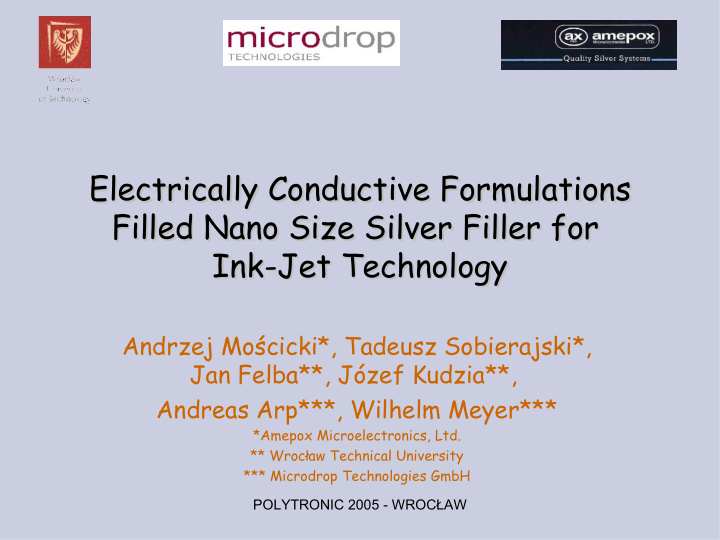



Electrically Conductive Formulations Electrically Conductive Formulations Filled Nano Size Silver Filler for Filled Nano Size Silver Filler for Ink-Jet Technology Ink-Jet Technology Andrzej Mościcki*, Tadeusz Sobierajski*, Jan Felba**, Józef Kudzia**, Andreas Arp***, Wilhelm Meyer*** *Amepox Microelectronics, Ltd. ** Wrocław Technical University *** Microdrop Technologies GmbH POLYTRONIC 2005 - WROCŁAW
New materials with nano size conductive fillers – New materials with nano size conductive fillers – new possibilities for applications. new possibilities for applications. New possibilities needs new type of equipment. New possibilities needs new type of equipment. New equipment – Ink Jet Dispenser Systems. Possibilities and requirements: • Single drop volume: 30 – 500 picoliters with variation approx. 1% • Droplet diameter: 30 – 100 µm • Drop rate: 0 – 2000 /sec. • Fluid viscosity range: 0.5 ~ 30 mPas. (unheated) • Drop acceleration: 10 5 g (during each shoot) POLYTRONIC 2005 - WROCŁAW
Ink Jet technology is well known for Ink Jet technology is well known for many applications especially when very many applications especially when very uniform fluid is used. uniform fluid is used. With formulations which are mixtuers of two different phases: fluid binder and solid filler – problem is much more complicated. Let’s use some classifications: •Mechanical type – classical, when filler over 0.5µm is used. •Colloidal type – when filler is in range 0.5µm ~ 50 nm. •True fluid type ( similar „molecular” type ) – when filler is less 20 nm. POLYTRONIC 2005 - WROCŁAW
Both: mechanical and colloidal types need Both: mechanical and colloidal types need very special ingredients and technology, but very special ingredients and technology, but always the major problem will be exist - always the major problem will be exist - sedimentation. sedimentation. Very low binder viscosity plus: Very low binder viscosity plus: - filler has much higher specific gravity, - filler has much higher specific gravity, - filler has much bigger particle size - filler has much bigger particle size than binder molecule size, than binder molecule size, Agglomeration - high % of filler inside formula - high % of filler inside formula Sedimentation POLYTRONIC 2005 - WROCŁAW Clogging
Different situation is when conductive Different situation is when conductive filler has diameter less 10 nm. Than filler has diameter less 10 nm. Than formulation is very uniform and stable as a formulation is very uniform and stable as a „true fluid”. true fluid”. „ Such a situation needs silver with particles size in range of several atoms. For preparing silver with size of nano range, thermal decomposition of silver salts were used. During very accurate studies this technology phenomena, Amepox established own process conditions and we are working with. POLYTRONIC 2005 - WROCŁAW
SEM Pictures ofNano Silver SEM Pictures ofNano Silver Agglomerates Agglomerates POLYTRONIC 2005 - WROCŁAW
STM Pictures ofNano Silver STM Pictures ofNano Silver POLYTRONIC 2005 - WROCŁAW
STM Pictures ofNano Silver STM Pictures ofNano Silver POLYTRONIC 2005 - WROCŁAW
Histogram for particles size Histogram for particles size o fAmepox o fAmepox nano Ag nano Ag Diameter of silver atom is 2.88 Å (1 nm = 10 Å) POLYTRONIC 2005 - WROCŁAW
Electrically Conductive Ink with Nano Electrically Conductive Ink with Nano Silver Silver Number of components One Consistency Very low viscous liquid Color Dark brown to black with metalic shade Percentage of silver filler (inside ink) 40 – 60 % ( actual 45% ) Specific gravity 1.3 – 1.6 g/cm 3 Viscosity 1.4 – 1.55 mPas Thixotropy index ~ 1.0 Surface tension value 28.5 – 34 dynes/cm Recommended sintering conditions 230 – 240 ˚C - 120 min Percentage of silver after „curing” 95 – 97 % Electrical resistivity ( 4 – 6 ) 10 -6 Ωcm Storage 6 months in room temperature POLYTRONIC 2005 - WROCŁAW
Ink-Jet Dispenser Shoot and Ink-Jet Dispenser Shoot and droplet forming droplet forming POLYTRONIC 2005 - WROCŁAW
Tests by Ink Jet Dispener Tests by Ink Jet Dispener POLYTRONIC 2005 - WROCŁAW
Results of Ink Jet tests Results of Ink Jet tests Dots: Macro Picture Nozzle 66 microns Nozzle 34 microns POLYTRONIC 2005 - WROCŁAW
Results of Ink Jet tests Results of Ink Jet tests Courtesy of TNO Industrial-Eindhoven Lines: Nozzle 66 microns Single line SEM picture Macro Picture POLYTRONIC 2005 - WROCŁAW
Advantages of Jet Printing Techniques Advantages of Jet Printing Techniques 1. Very high packaging possibility, 2. Nature of Nano Inks - formula is with the best homogeneous properties (uniform concentration), 3. The highest repeatability of dosing ink volumes, 4. Very high repeatability of printed shapes, X 200 POLYTRONIC 2005 - WROCŁAW x 50
Line resistance measurement results Line resistance measurement results Line number Electrode distance Resistance value Electrode distance Resistance value [Ω] [Ω] 1. 5 mm 5.2 25 mm 25.6 2. 5 mm 5.1 25 mm 25.6 3. 5 mm 5.2 25 mm 26.4 4. 5 mm 5.3 25 mm 26.2 5. 5 mm 5.3 25 mm 26.8 6. 5 mm 5.1 25 mm 25.8 7. 5 mm 5.2 25 mm 25.6 8. 5 mm 5.3 25 mm 26.2 Very high repeatability of resistance value show highly uniform formulation properties connected with perfect distribution of nano silver in unit volume. POLYTRONIC 2005 - WROCŁAW
Results of line thickness measurement Results of line thickness measurement Single layer of Nano-Ink formulation is extremely thin after curing process. Sample of thickness measurement result is showed on pictures: Courtesy of TNO Industrial-Eindhoven UBM Measurement Ag lines POLYTRONIC 2005 - WROCŁAW
Presented results are a part of EC Presented results are a part of EC founded project: founded project: G1RD-CT-2002-00656 G1RD-CT-2002-00656 „NANOJOINING” „NANOJOINING” POLYTRONIC 2005 - WROCŁAW
Recommend
More recommend